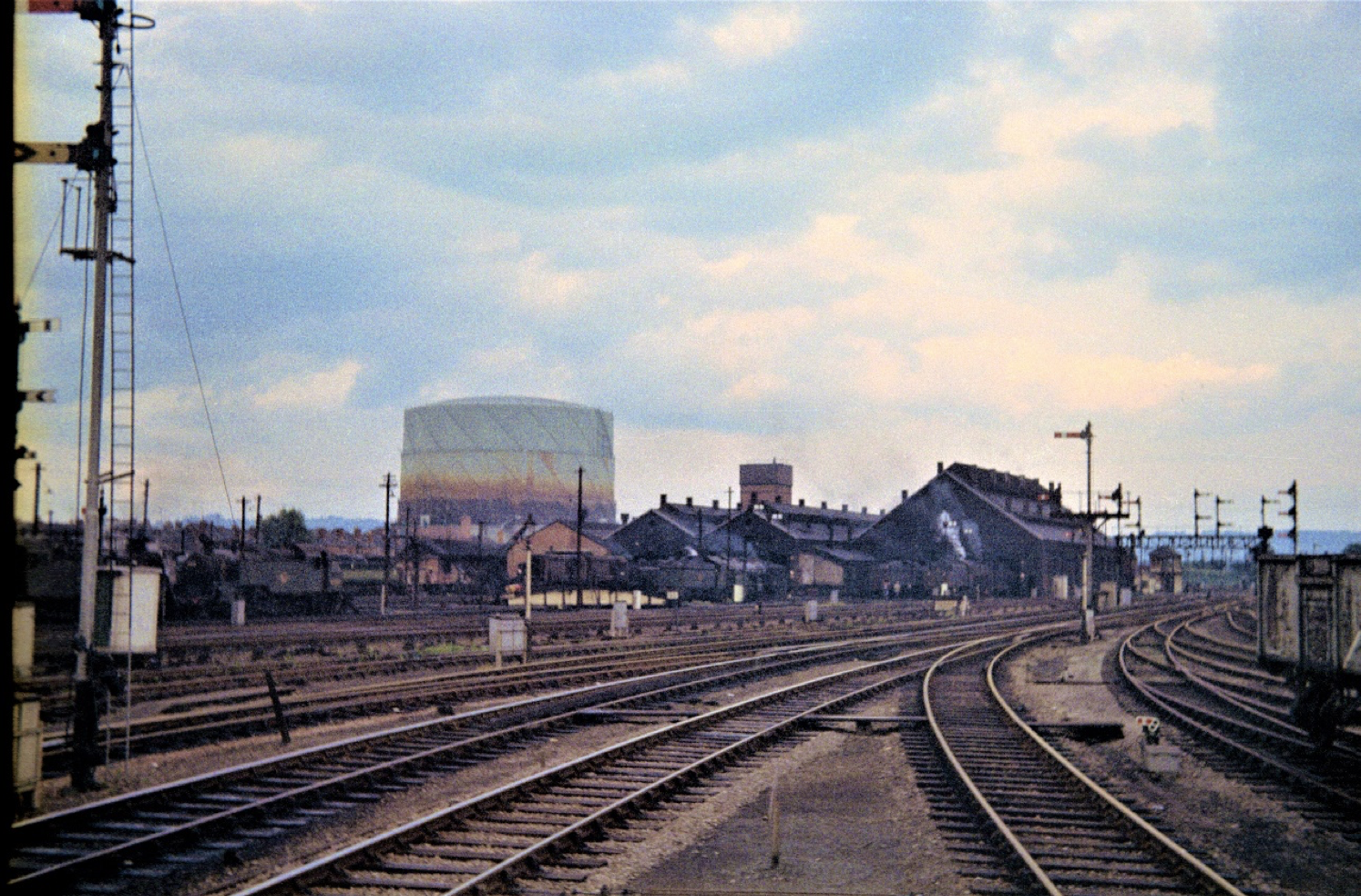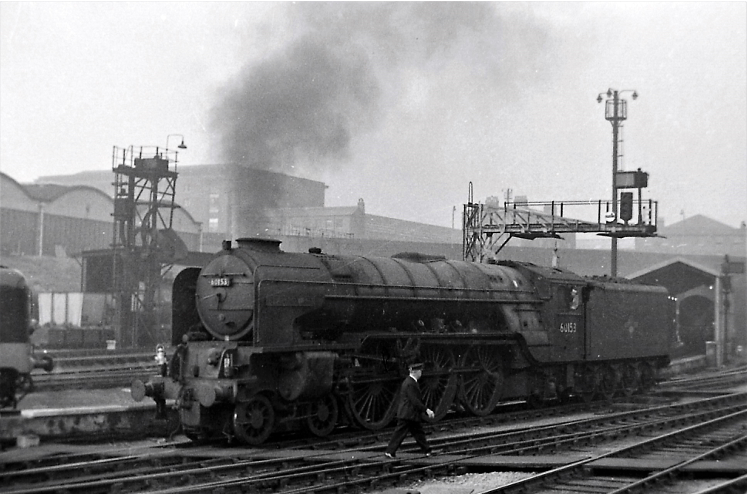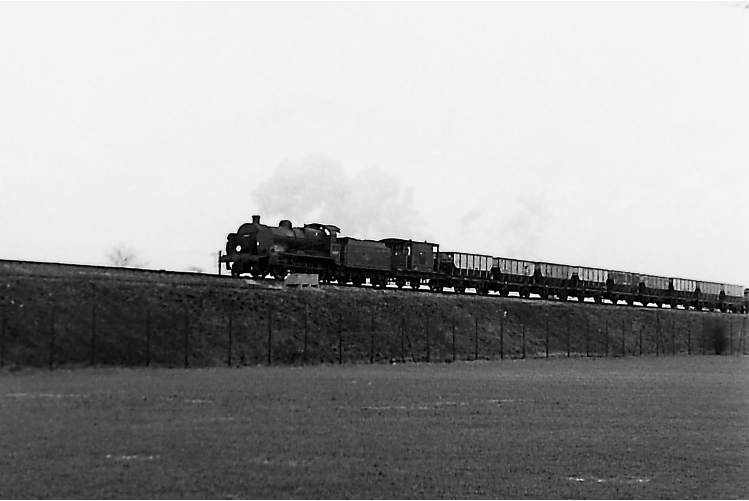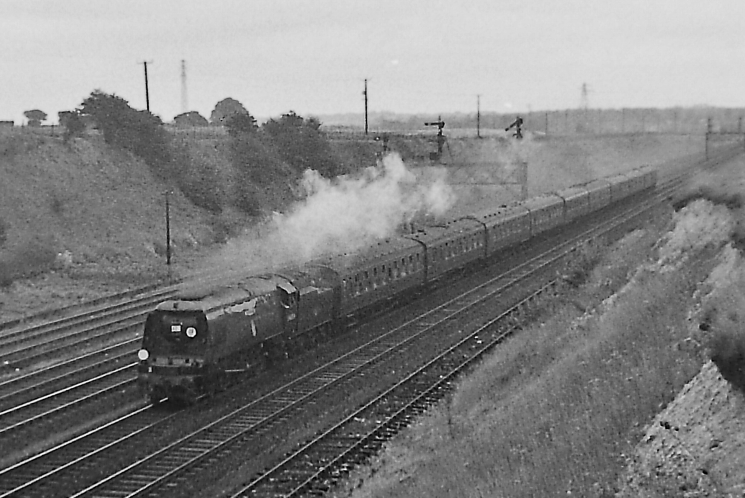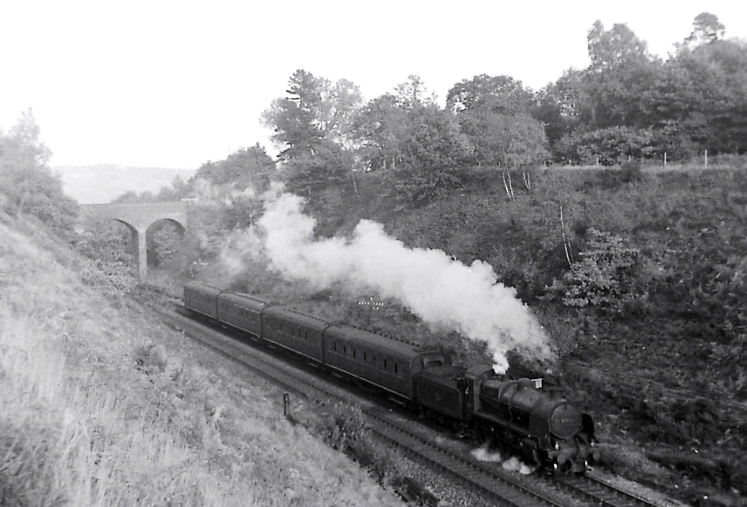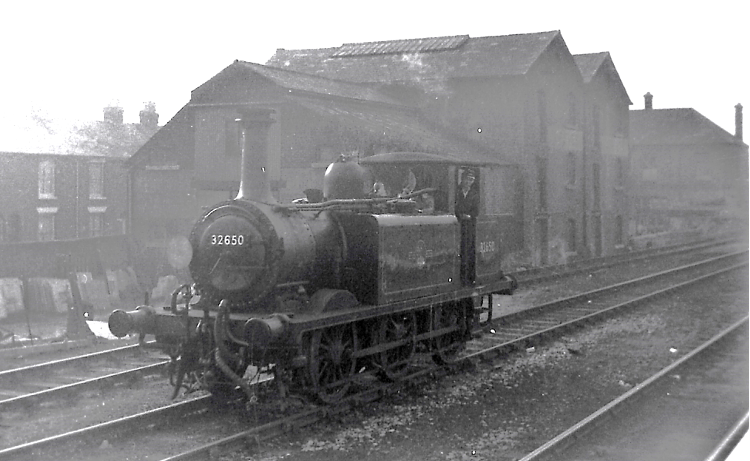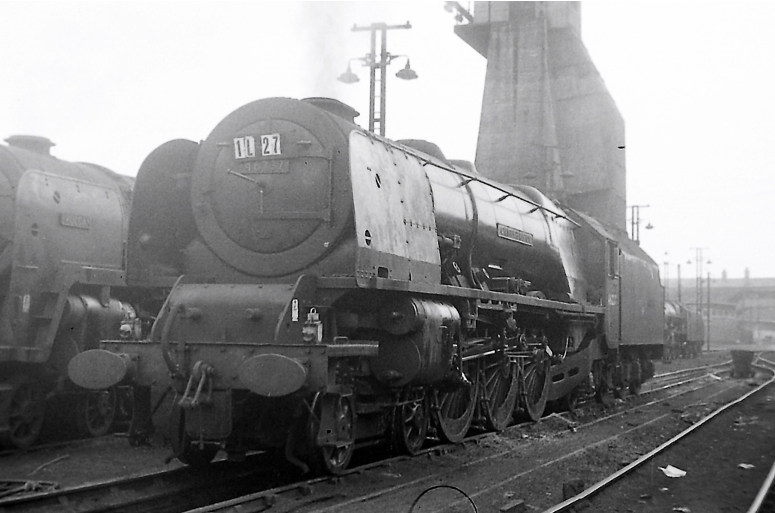1963: Leaving Gloucester for London
On 9 October 1962 I had travelled to London for a Civil Service interview at State House, High Holborn. The position was for a trainee cartographer at the Directorate of Overseas Surveys (DOS) in Tolworth, Surrey. Whilst in London, I took the opportunity to visit Kings Cross, where I managed to get a photo of a York ‘A1’, No. 60153 Flamboyant (with the nose of a Deltic in the foreground). Little did I realise it, but this would be the last winter of main-line steam at Kings Cross, as the steam depot closed on 4 June 1963, being replaced by Finsbury Park diesel depot.
‘A1’ Pacific No. 60153 Flamboyant enters King’s Cross servicing point after arriving with an express from York. The diesel age asserts itself with the intrusion of the nose of a ‘Deltic’ into the photograph.
The first two months of 1963 were marked by the coldest weather in living memory. After 12 inches of snow locally in Gloucester, temperatures remained resolutely below zero until the beginning of March. I was successful in my earlier interview, so on Sunday 3 March, with the thaw, I left home to join the DOS at Tolworth in SW London as a trainee cartographer. I travelled up on the afternoon train to Paddington to my lodgings with the Russell family in Cedarcroft Road, Chessington.
Buses around Surbiton
My first transport impressions were confined to London Transport red buses on the A3 Kingston Bypass, along which I walked to work. RTLs from Riverside, Hammersmith (R) worked the 72 from Esher to East Acton, whilst RTs from Merton garage (AL) worked the 152 from Hampton Court (Feltham in peak hours) to Mitcham. Tolworth itself was served by buses on country route 406 from Kingston to Redhill, worked by green London Transport RTs from Leatherhead (LH) and Reigate (RG) garages, although with much higher frequencies than I was accustomed to on rural routes, and with an Express service at peak times with blue blinds. If I wanted to go into Kingston, I could walk to the Hook underpass, catch a 65 (from Leatherhead to Ealing) or 265 (from Copt Gilders Estate to Kingston), being RTs worked from Norbiton (NB) or V garage (it took me a while to work out that V was the garage code for Turnham Green!)
Within a few months I had moved to Surbiton, staying in St Andrews Road with Mrs Kilpatrick. From there, I caught the 281 to work, which ran from Twickenham to Tolworth, worked by Fulwell (FW) Routemasters, or occasionally the 283, a Kingston circular route worked by NB Routemasters. These routes had only recently received these buses as part of the last phase of the London trolleybus conversion in March 1962. Both routes were quite frequent, so bunching was quite commonplace This was not surprising as it was not in the nature of older ex-trolleybus drivers to overtake any other bus – after all it was not possible if you were driving a trolleybus!
Another service that used the Kingston Bypass was the Green Line route 715 from Guildford to Hertford. This was operated by RMC coaches, although to my eyes, their only concession to coach travel was the existence of luggage racks and slight deeper squabs for bus seats. They certainly did not have headrests you would expect in proper coaches. Even so, because they were limited stop, they were useful for long journeys, and for my first trips home I would take the 715 immediately after work on a Friday evening from Tolworth to Shepherds Bush Green. Here I could catch a Black & White Motorways coach to Gloucester outside the BBC Television Theatre.
The 5.15pm from Victoria called at Shepherds Bush at 5.45pm and drove up the Uxbridge Road, calling there at 6.30pm. This was often a drag, as the coach was not due into Gloucester until 10.17pm after a refreshment stop at Stokenchurch. The alternative was to catch a later express coach from Victoria at 6.30pm, which by using Western Avenue would still get to Gloucester at about the same time, running non-stop from Uxbridge to Cheltenham. A return ticket cost £1/5/3d. I occasionally caught this coach at Uxbridge. In this case I would take a 152 from Tolworth via Hampton Court through Bushy Park to Feltham; the 285 to Heathrow Airport Central and finally the 223 from there to Uxbridge. This was a long journey not recommended with a suitcase!
The local railway scene around Surbiton
My first experiences of local rail services were confined to activities on branch line from Motspur Park to Chessington South. The electrification of London suburban services out of Waterloo had been completed by 1929, and the half-hourly service from Waterloo to Chessington South (headcode 18) was normally worked by 4-SUB EMUs. However, steam used to make a daily appearance on the branch with a rake of high-capacity coal hopper wagons to Chessington coal concentration depot, normally passing the DOS offices around morning-break time. These trip workings would be powered by anything that 70A or 70B had to hand, including the occasional Bulleid Pacific. One Saturday I took a photo of ‘U’ 2-6-0 No. 31809 on this train.
‘U’ class 2-6-0 No. 31809 approaches Tolworth with the returning empties from Chessington coal concentration depot to Wimbledon West Yard on 16 March 1963. This duty was worked regularly by locomotives from Nine Elms, and a wide variety of power appeared on this turn during this time.
Within six months, I found lodgings in Surbiton within 200 yards of the station, realising it provided a superb place for observing the last days of steam on the South-Western division out of Waterloo. I soon became acquainted with the local services. There were three regular half-hourly services to Waterloo calling at Surbiton. The semi-fast service to Portsmouth Harbour and Alton (headcodes 7 and 12), which split at Woking, were worked by 2-BILs and 2-HAPs dating from 1930s; the service via the Guildford new line (42), which called at Wimbledon, was the preserve of BR Standard 4-EPBs; whilst the all-stations local service to Hampton Court (30) was worked by 4-SUBs. The only other electric services were the fast Portsmouth line services (80), leaving Waterloo at 50 minutes past the hour, worked by 12-car sets of 4-CORs, built for the electrification of the line in 1935.
Otherwise, passenger services were all steam-hauled, although the recently introduced D6500 diesels were used on summer Saturdays, particularly to work trains to Lymington or Swanage. If I wished to go up to London in the evening, it was possible to catch a steam-hauled train at 5.12pm or 6.47pm to Waterloo, being semi-fasts from Basingstoke. On either of these trains it was possible to be treated to a run behind one of a variety of locomotives ranging from ‘WCs’ to ‘U’ class 2-6-0s.
Southern steam further afield
Whilst steam still reigned supreme on the LSW main line out of Waterloo beyond Brookwood, there was less variety in terms of locomotive classes when compared with five years previously. Unfortunately, all the ‘Lord Nelson’ class had been withdrawn in October1962, despite six remaining in use on freight duties from Feltham in June of that year. During 1962 a couple of ‘L’/’L1’ class SECR 4-4-0s that had escaped the Kent Coast electrification managed to find some employment on the lines out of Waterloo, and between Guildford and Redhill, but by the end of the year these classes were extinct along with the ‘H15’ and ‘C2X’ classes. Schools displaced from the dieselisation of the Hastings line were working the Reading – Redhill line by mid-1962. On the Central Division, the remaining ‘E4s’ and ‘E6s’ were concentrated at Brighton. ‘LNs’, ‘N15s’ and ‘700’ classes were being cut up at Ashford, but before long the works would be closed to steam. However, a ‘T9’, No. 120, was restored to LSW livery and allocated to 71A which still had ‘King Arthurs’ in use.
By this time, the Southern had received several WR 0-6-0PTs to replace some of the more superannuated SR types, such as the ‘M7s’ on ECS workings from Clapham Junction to Waterloo and ‘R1s’ which worked the Folkestone Harbour branch. The pannier tanks did not last long at Clapham Junction though as they were replaced on ECS movements by Standard tanks. At Folkestone, the pannier tanks were made redundant by the implementation of stage 2 of the Kent coast electrification in June 1962. ‘Q1s’ from Tonbridge were also cascaded to the Western Division due to electrification. On the diesel front, D6500 locos built to Hastings line dimensions were entering service, and the cascading of the more modern Southern steam power to Western Division lines continued.
On 22 June 1963, at Vauxhall I met Jeff Treece who was already working at the DTI in London, to carry out a survey of summer Saturday traffic over the period 10.30am to 2.30pm. The details are provided in a separate spreadsheet. Almost all the expresses on the Bournemouth and Exeter lines were steam hauled, Bulleid Pacifics dominating the workings, along with Standard classes. But already the D6500 class were working Lymington Pier services and some secondary Bournemouth line trains. The Portsmouth Harbour service was augmented: the 12-car 4-COR sets working the expresses were supplemented by a few new 4-CEP sets which presumably would normally be working the Portsmouth/ Bognor Regis fast services from Victoria. Stopping services (7 and 12) from Portsmouth and Alton were worked by 2-BIL/2-HAL sets, but with duplicates formed of suburban sets, including one 4-EPB set. ECS workings between Clapham Junction and Waterloo were in the hands of Standard class ‘3’ tanks (including Nos. 82024/5 recently transferred from the NER), and Standard 2-6-4Ts. Otherwise, the variety of locos was not large, although ex-SR locomotives noted included ‘W’ class 2-6-4T No. 31917, and ‘N’ class 2-6-0 No. 31812 on ECS workings; whilst ‘S15’ 4-6-0 No. 30840 came up from Walton-on-Thames with empty stock on train 237. Another interesting sighting was the milk empties working which, after cleaning, were taken up to Waterloo from Wood Lane via the Reading lines to run around before working back to Devon from Clapham Junction at 3.45 pm, normally a 72A un-rebuilt Bulleid working. One concluding impression was that, on the main line at least, the network out of Waterloo was working to capacity for most of the time we were making observations.
This experience encouraged me to observe several more Saturdays, so on July 27, I went to Esher. There was plenty of steam activity during the main part of the day, but few numbers seem to have been recorded. However, the up ECS working from Walton-on-Thames was again rostered for a 70B ‘S15’. Summer Saturday surveys were also undertaken in at Surbiton and Esher in 1964 and 1965, but the level of activity did not match that of 1963.
A calamity occurred on the 9 August 1963 when a fire at Waterloo disrupted the Friday evening rush-hour. I have a photo of ‘MN’ Pacific No. 35028 Clan Line crawling through Surbiton on the 6.0pm to Exeter. A day later I was photographing steam from the cutting to the east of Basingstoke station.
Ex-works Bulleid Pacific No. 34084 253 Squadron heads west through the cutting on the approach to Basingstoke with a summer Saturday express to Bournemouth on 10 August 1963. Note the old SR signals on the gantry on the up line.
On 1 September, I took a Sunday excursion from Surbiton to Exeter hauled by No. 34095 Brentor, which I timed. The train called at Andover Junction, Salisbury, Sherborne, Yeovil Junction, Axminster, Seaton Junction and Sidmouth Junction.
On two Saturdays later that month, I purchased day-rover tickets that gave unlimited travel on trains in an area to the south-west of London bounded by the Brighton line, Windsor line and the Guildford – Reigate line, enabling me to see some of the remaining steam on the Central division at Norwood Junction and Redhill. Redhill shed still had Bulleid Pacifics visiting, presumably from the Brighton line, and on 7 September a withdrawn ‘H’ class 0-4-4T, No. 31542 was in evidence. The tickets also allowed travel the Guildford to Redhill line, trains being hauled in the main by SR ‘U’ and ‘N’ 2-6-0s and Standard ‘4’ 4-6-0s. Later, on 19 October, I took a bike ride along the foot of the North Downs and photographed a westbound train at Albury Heath.
Class ‘N’ 2-6-0 No. 31413 climbs to the summit at Albury Heath with the 4.4pm Redhill to Reading on 19 October 1963.
Following the publication of the Beeching Report, some rural services were threatened with closure, and I wanted to record them before they vanished for good. The Havant – Hayling Island branch was one and was still being worked by the diminutive ‘A1X’ 0-6-0Ts. During my trip on the branch on 26 October 1963 I managed to photograph an immaculate No. 32650 in charge of the branch. On my return, I took photographs on workings in the Guildford area; the Guildford – Horsham service still being worked by Ivatt 2-6-2Ts. This service was later earmarked for withdrawal: the final trains on 12 June 1965 were witnessed by crowds of observers.
‘AIX’ 0-6-0T No. 32650 rests at Havant between duties on the Hayling Island branch on 26 October 1963.
Other London-based trips
Now that I had the opportunity to explore the London area further, on 16 March I made a first trip to Watford Junction for the day from Chessington. My residence in Surbiton also gave me the opportunity to explore beyond those parts of the Southern network I had already seen (Exeter and Portsmouth), including a trip to Brighton on 11 May. I also photographed No. 4472 Flying Scotsman at Northwick Park on a special returning to Sheffield from Marylebone on 15 June.
As Roger Speck had now joined me and Jeff Treece working in London, Jeff arranged a trip on 20 July 1963 visiting 1A and 1B, managing to photograph ‘Semis’ at both sheds. ‘King’ No. 6005 King George II was also seen on 81A, in store with other ‘Kings’ and ‘Castles’. However, steam was still in use on Worcester trains, and as late as 31 August I photographed a rather scruffy No. 7023 Penrice Castle arriving at Paddington, a sorry contrast to the burnished condition in which 85A ‘Castles’ were presented only a year earlier when I had photographed them between Evesham and Moreton-in-Marsh.
A scene on Camden motive power depot on 20 July 1963. ‘Coronation’ Pacific No. 46237 City of Bristol prepared ready to work 1L27 to Liverpool, alongside ‘Britannia’ Pacific No. 70024 Vulcan, with an unidentified ‘Royal Scot’ 4-6-0 in the background.
